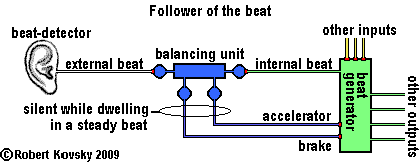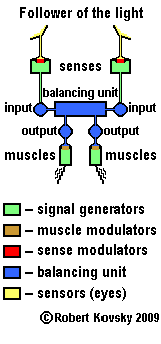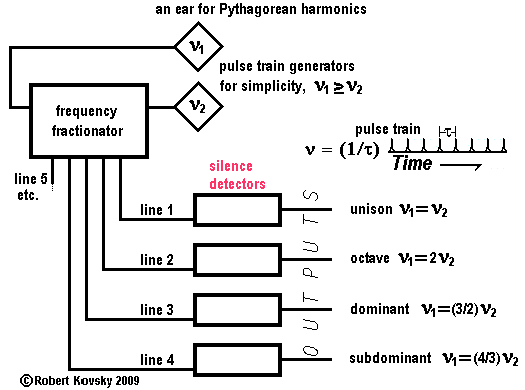

| ["Dwelling" is a foundational principle in my psychological model of experience. It is self-sustaining activity of the simplest kind. More complex levels of activity are "following" and "balancing." Experiences of "dwelling" also occur while a person is "coasting" in an automobile (no acceleration, no brake) or "gliding" in an airplane. The "follower of the light" in the adjacent Image is a design for a "bug" that lives in a watery domain also inhabited by "the light." The light-follower uses principles (similar to those operating in the beat-follower) to "follow the light" as the light moves in the domain. The "dwelling" activity of the light-follower is to move "straight ahead toward the light" with both eye sensors equally illuminated and both "motor units" (muscles, governed by modulators) operating at full speed. During "dwelling," the muscle modulators are silent. If the light shifts away from "straight ahead," one eye receives less illumination than the other, and pulses that are put out by the balancing unit slow down one motor unit. The differential in motor units works physically (mechanically) so that the organism turns and, therefore, "follows the light." The outline of activity is "the same" as for the follower of the beat: a deviation from balance and silence leads to "following" activity that corrects the deviation and restores balance and silence.] |

|
| [...]Performers |
| 1. Silence |
| 2. Dwelling |
| 3. Following |
| 4. Balancing |
| 5. Repeating |
| 6. Proliferating |
| 7. Shimmering |
| 8. Resolution |
| 1. Silence |
Each of my experiences arises during processes that establish activity patterns in my brain. As a chief mode of operations, a brain generates families of activity patterns that are related by resemblances. When a person acts, some activity patterns are selected and others are extinguished or rejcted. Sometimes a person freely selects among activity patterns to decide the person's next act; and, often, the selection is forced. We know and describe much of our experience, and especially our selections, in terms of resemblances and comparisons. "Atom-molecule" constructions (noted above in B.1) can only partially model such resemblances and comparisons, although some models may be quite good under some limited circumstances.For musical experience, the principles assert that each sustained element of musical experience corresponds to an activity pattern that is shared among brains, meaning by "element" any of the usual components of music, e.g., meter/rhythm, harmony and melos. Different meters and rhythms are related by resemblances; different harmonies are related by resemblances; and different melodies are related by resemblances. The families of resmblances and their members are constructional elements of experience, such as elements of musical experience. "Resemblances" includes "opposites," e.g., melodic and harmonic inversions. The "familes" mentioned in the foundational principles include up-and-down, postive-and-negative, left-and-right. A family may have two members (black-and-white) or an infinite number (rainbow). Resemblances extend across different kinds of experience, enabling us to compare music with motion, music with drama, music with light, even music with architecture. We can see a universe in a grain of sand or a drop of water. According to legend, at least, Newton saw a universal force that acted "the same" on a falling apple and on our Moon circling the Earth. "Shimmering" occurs when two or more distinct activity patterns are competing for possession of a person's brain. The activity pattern that wins the competition will take the person on the next step of the person's current activity. Sometimes when shimmering occurs, e.g., when a person is selecting from a dinner menu at a restaurant, the person freely decides which activity pattern wins. In composed music, the composer decides for the performers and the audience. [The central operating principle of my Quad Nets Model of brains is "Shimmering Sensitivity," mimicking a selection of a winning activity pattern in the brain as a result of shifts among and between multiple influences, including very tiny influences that may become all-important in the selection.] In harmonic music, a harmony is a single, sustained activity pattern - a structure of tones and silences. While things are "in harmony," there is little if any impulse towards movement. Dissonance, on the other hand, creates a shimmering activity pattern, namely, activity of the brain where the next step could take place in more than one direction. Musical dissonance is a source of "pressure" or "driving force" that became dominant in the 18th and 19th centuries, e.g., in the music of Beethoven and Wagner. Pressure and driving force are found in dramatic situations where the emotional action is "shimmering" and, at least to the persons "in the roles," events can go "either way." Musical force and pressure originated with operatic dramatic performances and developed afterwards into non-vocal dramatic performaces. Dramatic pressure and force were decidedly different from the steady stream of sound in Renaissance concert music (church and court) prior to 1600. After 1600, Western music was completely transformed, changing from steadiness to drama. Monteverdi's Duo Seraphim was one of the first fruits of that transformation. In measures 10 through 14 of Extract 1 (see corresponding portion of performing score in the image below), Monteverdi first creates a dissonance and then constructs a path to resolve it that has several steps, each step made up of a a resolution followed by a new dissonance. There is a series of "suspended disonnances." Steps closely resemble other in a repetitious way. In this passage, I hear beauty and repose. I suggest that repeated steps of dissonance and resolution in Extract 1 create a beauty that was novel with Monteverdi and his contemporaries. I suggest that Moteverdi's repetition of steps generates another kind of silence, one that was new in his time. The silences in my brain models suggest an account for this development. Further extensions of the models show how beautiful shimmering silences might be generated through time-displaced phrasal repetitions, e.g., those in Extract 2.

Return to top of the page.
- Performances of Muscular Coordination
- Please visit "Dancer -- Shimmering Gaits of a Six-legged Engineered Organism." A "gait" is repeated coordinated activity of legs and "shimmering gaits" are switches between gaits that the organism employs, e.g., to climb over an obstacle.
Performances of Verbal Communication
- E.g., a lawyer obtaining testimony from a witness by examination in court.
Performances of Dailylife Maintenance
- E.g., scheduling and completing errands in a world of detours and delays; making a casserole from a recipe when you don't have all the ingredients.
Performances of Knowledge Construction- E.g., knowledge constructed during the 19th century "paradigm shift" from "the particle theory of light" to "the wave theory of light" as discussed in my Testimony of Freedom.
Performances of Institutional Responsibilities- E.g., resolving a dispute through civil litigation. (Please see material in my archive, The Crucible. Additional materials based on pending cases will be referenced later.)

Please visit other sites in the "Quad Nets" family:: Timing Devices: the original presentation of the timing devices system. The message is that brains are not computers.
Quad Nets: general designs for brain-like devices; timing devices are a special class of devices within the more general class.
Embodiment of Freedom: integrated models - based on Quad Nets - of brains and experience, physics and psychology.
Testimony of Freedom: re-states prior models and extends the inquiry into social and spiritual matters.
| Your comments and suggestions are welcome and may be of assistance. Please write to: |

|